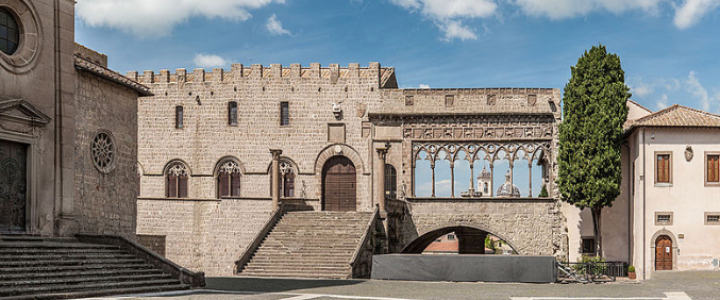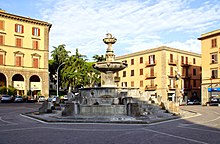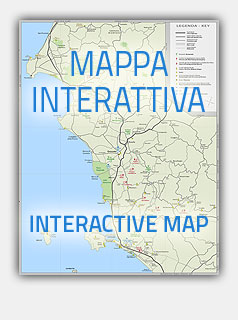
The first report of the new city dates to the eighth century CE, when it is identified as Castrum Viterbii. It was fortified in 773 by the Lombard King Desiderius in his vain attempt to conquer Rome. When the popes switched to the Frankish support, Viterbo became part of the Papal States, but this status was to be highly contested by the emperors in the following centuries, until in 1095 it is known it was a free comune.

In a period in which the popes had difficulties asserting their authority over Rome, Viterbo became their favourite residence, beginning with Pope Eugene III (1145–1146) who was besieged in vain in the city walls. In 1164, Frederick Barbarossa made Viterbo the seat of his antipope Paschal III. Three years later he gave it the title of “city” and used its militias against Rome. In 1172, Viterbo started its expansion, destroying the old city of Ferento and conquering other lands. In this age it was a rich and prosperous comune, one of the most important of Central Italy, with a population of almost 60,000.
Main sights

Viterbo’s historic center is one of the best preserved medieval towns of central Italy. Many of the older buildings (particularly churches) are built on top of ancient ruins, recognizable by their large stones, 50 centimeters to a side. Viterbo is unique in Italy for its concentration of ‘profferli’, external staircases that were a frequent feature of medieval houses. The San Pellegrino quarter has an abundance of them, reflecting an architectural style that is unique to the town and the nearby region.[2]
- Palazzo dei Papi or Papal Palace: A main attraction of Viterbo, the palace hosted the papacy for about two decades in the 13th century, and served as a country residence or refuge in time of trouble in Rome. The columns of the palace are spolia from a Roman temple.
- Cathedral of S. Lorenzo: The Cathedral was originally erected as episcopal see of the exempt bishopric of Viterbo in Romanesque style by Lombard architects at the site of an ancient Roman temple of Hercules. It was rebuilt from the sixteenth century on, and heavily damaged in 1944 by Allied bombs. The Gothic belfry was built in the first half of the 14th century, and shows influence of Sienese architects. The church houses the sarcophagus of Pope John XXI and a picture Christ Blessing (1472) by Gerolamo da Cremona.
- Palazzo Comunale (town hal; begun 1460), Palazzo del Podestà (magistrate’s residence; 1264) and Palazzo della Prefettura (police HQ; rebuilt 1771): three civic buildings around the central square, Piazza del Plebiscito. The Palazzo Comunale houses a series of 17th century and Baroque frescoes by Tarquinio Ligustri, Bartolomeo Cavarozzi and Ludovico Nucci.
- Santa Maria della Salute: a small Gothic church with a highly decorated portal.
- Chiesa del Gesù: Romanesque-style 11th-century church. The sons of Simon de Montfort and Henry of Almain, son of Richard, Earl of Cornwall were stabbed to death.
- Palazzo Farnese: This 14th-15th-century palace was the childhood home of Alessandro Farnese, the future Pope Paul III, and his beautiful[citation needed] sister, Giulia Farnese.
- Rocca (castle).
- Santa Maria Nuova (11th-century), San Sisto (second half of 9th-century), and San Giovanni in Zoccoli (11th-century): three Romanesque churches.
- Palazzo degli Alessandri: a typical medieval patrician house in central Viterbo.
- Fontana di Piazza della Rocca: public fountain in the center of the Old Town, construction 12th–16th century.
- Fontana Grande: public fountain, construction began in 1206.
- San Francesco: gothic church built over a pre-existing Lombard fortress. It has a single nave with a Latin cross plan. It houses the sepulchre of Pope Adrian V, who died in Viterbo in 1276, considered the first monument by Arnolfo di Cambio.
- Sanctuary of Santa Rosa: church is a sober 19th-century reconstruction, where every year a new Macchina di Santa Rosa, or dedicatory tower is displayed.

- Museo Civico: the (City Museum) houses many archeologic items from the pre-historic to Ancient Roman times, plus a Pinacoteca (picture gallery) with works by Sebastiano del Piombo, Antoniazzo Romano, Salvator Rosa, Antiveduto Grammatica and others.
- Orto Botanico dell’Università della Tuscia: botanical garden operated by the university.
Baths of Viterbo
In the valley of the Arcione River just to the west of Viterbo are a number of springs celebrated for the healing qualities of their waters, and in use since Etruscan and Roman days. In fact, the imposing ruins of a great Roman bath are still to be seen and were drawn in plan and perspective by Renaissance artists including Giuliano da Sangallo, Michelangelo, and Vasari.One of the most famous were the thermal springs known as the “Bulicame”, or bubbling place, whose reputation had even reached the ears of the exiled poet Dante Aligheri. Canto 14 (lines 79–81) of Dante’s Inferno describes how:
In silence we had reached a place where flowed
a slender watercourse out of the wood—a stream
whose redness makes me shudder still.
As from the Bulicame pours a brook whose
waters are then shared by prostitutes, so did this
stream run down across the sand.
Not far from the Bulicame, whose waters were apparently always taken in the open, is the Terme dei Papi (Bath of the Popes). Almost totally concealed within the structure of a modern luxury spa hotel are the remains of a Renaissance bath palace that attracted the attention of two popes. Actually, the origins of this bathing establishment date to the Middle Ages when it was known as the Bagno della Crociata (named either after a Crusader who supposedly discovered the spring or from a corruption of the Italian word for crutch). Early 15th-century documents describe a bath building that covered three distinct thermal springs all under one roof.
https://en.wikipedia.org/wiki/Viterbo






 Home
Home Home
Home